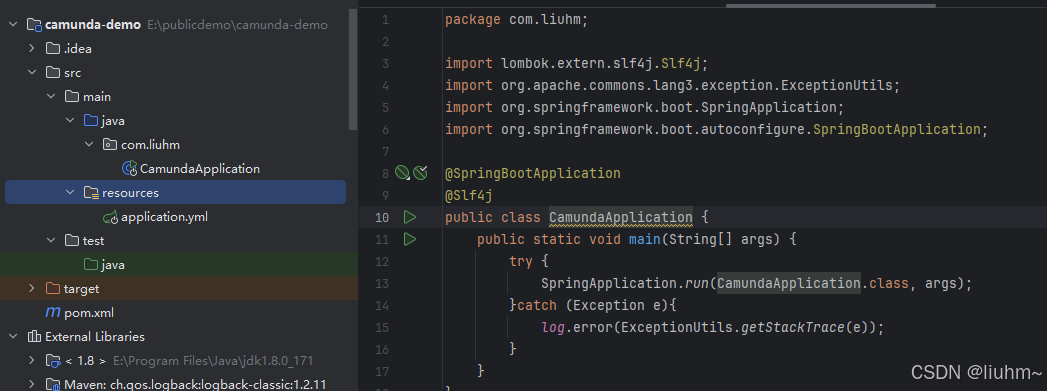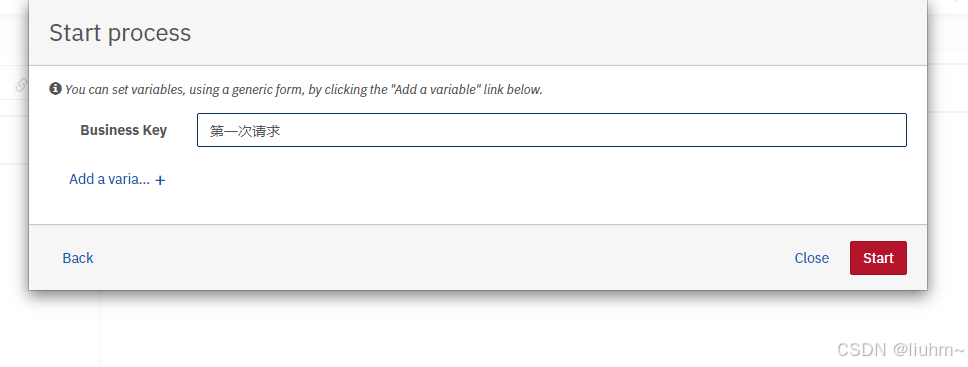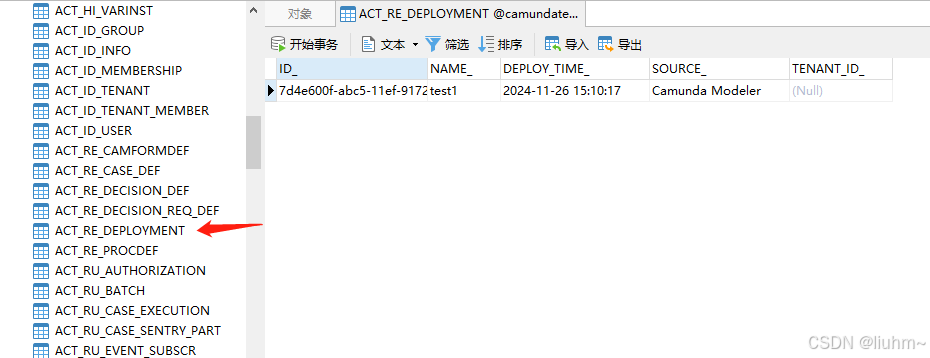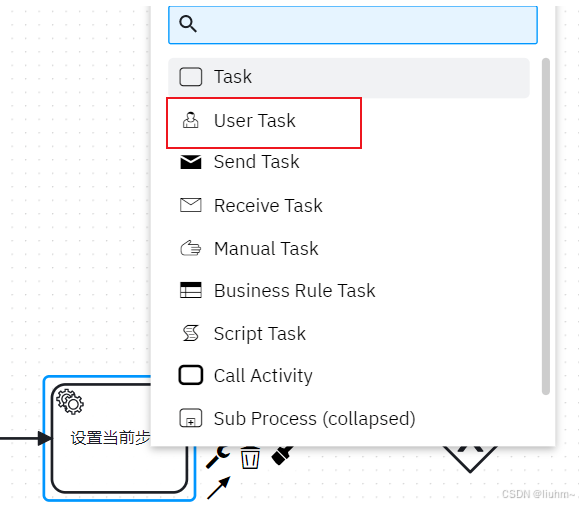Spring Boot 项目集成camunda流程引擎
使用camunda开源工作流引擎有:通过docker运行、使用springboot集成、部署camunda发行包、基于源代码编译运行等多种方式。
文本重点介绍如何在Spring Boot应用程序中如何集成Camunda Platform开源流程平台,这也是项目中最为常见的一种使用方式。
在本教程中,我们假设您熟悉 Java Web 应用程序开发和 Spring Boot 的基础知识。前提条件是您已经安装了 Eclipse/IDEA等Java开发工具和 Camunda Modeler流程设计器。
1.新建Spring Boot 项目集成camunda
首先,让我们在您选择的 IDE 中设置您的第一个流程应用程序项目。
该项目需要 Java jdk8以上版本。我本地使用的JDK版本为8,使用的开发工具IDEA2024。
1.1. 添加 Camunda 平台和 Spring Boot 依赖项
下一步包括为新项目设置 Maven 依赖项。需要将 Maven 依赖添加到项目的文件中。由于本示例要使用camunda流程引擎、web界面、Rest服务接口,所以需要导入camunda-bpm-spring-boot-starter-rest、camunda-bpm-spring-boot-starter-webapp依赖包。我们在"依赖管理"部分添加了 Spring Boot BOM和camunda相关依赖,这将自动将 camunda 引擎、rest服务接口和 Web 应用程序包含在应用程序中。
我们使用camunda7.19.0版本,该版本支持jdk8和springboot2。camunda和springboot版本的依赖对应关系,查看官方文档说明:Spring Boot Version Compatibility | docs.camunda.org

xml
<?xml version="1.0" encoding="UTF-8"?>
<project xmlns="http://maven.apache.org/POM/4.0.0"
xmlns:xsi="http://www.w3.org/2001/XMLSchema-instance"
xsi:schemaLocation="http://maven.apache.org/POM/4.0.0 http://maven.apache.org/xsd/maven-4.0.0.xsd">
<modelVersion>4.0.0</modelVersion>
<artifactId>camunda-demo</artifactId>
<name>camunda-demo</name>
<groupId>com.liuhm</groupId>
<version>1.0</version>
<description>Demo project for Spring Boot</description>
<properties>
<java.version>1.8</java.version>
<spring-boot.version>2.7.5</spring-boot.version>
<camunda.spring-boot.version>7.19.0</camunda.spring-boot.version>
</properties>
<dependencyManagement>
<dependencies>
<dependency>
<groupId>org.springframework.boot</groupId>
<artifactId>spring-boot-dependencies</artifactId>
<version>${spring-boot.version}</version>
<type>pom</type>
<scope>import</scope>
</dependency>
</dependencies>
</dependencyManagement>
<dependencies>
<dependency>
<groupId>org.camunda.bpm.springboot</groupId>
<artifactId>camunda-bpm-spring-boot-starter-webapp</artifactId>
<version>${camunda.spring-boot.version}</version>
</dependency>
<dependency>
<groupId>org.camunda.bpm.springboot</groupId>
<artifactId>camunda-bpm-spring-boot-starter-rest</artifactId>
<version>${camunda.spring-boot.version}</version>
</dependency>
<dependency>
<groupId>org.springframework.boot</groupId>
<artifactId>spring-boot-starter-jdbc</artifactId>
</dependency>
<dependency>
<groupId>mysql</groupId>
<artifactId>mysql-connector-java</artifactId>
<version>5.1.47</version>
</dependency>
<dependency>
<groupId>com.sun.xml.bind</groupId>
<artifactId>jaxb-impl</artifactId>
<version>2.3.6</version>
</dependency>
<dependency>
<groupId>org.projectlombok</groupId>
<artifactId>lombok</artifactId>
<version>1.18.28</version>
</dependency>
</dependencies>
<build>
<finalName>${project.artifactId}</finalName>
<plugins>
<plugin>
<groupId>org.springframework.boot</groupId>
<artifactId>spring-boot-maven-plugin</artifactId>
<version>${spring-boot.version}</version>
</plugin>
<!--指定JDK编译版本 -->
<plugin>
<groupId>org.apache.maven.plugins</groupId>
<artifactId>maven-compiler-plugin</artifactId>
<configuration>
<source>1.8</source>
<target>1.8</target>
<encoding>UTF-8</encoding>
</configuration>
</plugin>
</plugins>
</build>
</project>1.2. 配置 Spring Boot 项目
在项目中src/main/resources新建application.yml
让我们在文件夹中创建一个包含以下内容的文件:application.yml
默认在mysql数据库中创建了camundatest
yml
spring:
datasource:
url: jdbc:mysql://192.168.0.154:3306/camundatest?characterEncoding=UTF-8&useUnicode=true&useSSL=false&zeroDateTimeBehavior=convertToNull&serverTimezone=Asia/Shanghai
username: root
password: 123456
driver-class-name: com.mysql.jdbc.Driver
camunda:
bpm:
database:
type: mysql
schema-update: true # 是否自动建表,但我测试为true时,创建表会出现,因此还是改成false由手工建表。
auto-deployment-enabled: false # 自动部署 resources 下的 bpmn文件
admin-user:
id: admin
password: 123456
server:
port: 8080此配置将导致以下结果:
- 将创建具有提供的密码和名字的管理员用户 admin/123456。
- 认使用mysql数据库,启动时自动创建数据库。
1.3. 编写Spring Boot启动类
接下来,我们添加一个带有 main 方法的应用程序类,该方法将成为启动 Spring Boot 应用程序的入口点。该类上有@SpringBootApplication注解,它隐含地添加了几个方便的功能(自动配置、组件扫描等 - 参见 Spring Boot 文档)
java
package com.liuhm;
import lombok.extern.slf4j.Slf4j;
import org.apache.commons.lang3.exception.ExceptionUtils;
import org.springframework.boot.SpringApplication;
import org.springframework.boot.autoconfigure.SpringBootApplication;
@SpringBootApplication
@Slf4j
public class CamundaApplication {
public static void main(String[] args) {
try {
SpringApplication.run(CamundaApplication.class, args);
}catch (Exception e){
log.error(ExceptionUtils.getStackTrace(e));
}
}
}1.4. 启动Spring Boot工程
在IDEA的maven操作窗口,执行mvn clean install命令,下载相关的第三方Jar包。
1.4.1. 启动
我们的第一个 Camunda Spring Boot 应用程序现已准备就绪,此程序是一个 Spring Boot 应用程序,它作为 Web 容器、Camunda 引擎和 Camunda Web 应用程序资源嵌入到 Tomcat 中,并使用了mysql 数据库。您可以通过右键单击该类并选择CamundaApplication来运行应用程序。

1.4.2. 访问
现在,在浏览器中打开 http://localhost:8080/ 时,您可以使用我们之前配置的登录名和密码"admin/123456"来访问 Camunda Web 应用程序。

能正常登录访问这个界面,表示基于springboot集成camunda成功了。
1.4.3. 数据库表
数据库也创建了表

执行完成后,通过工具打开数据库控制台查看,一共有49张表。
执行的sql脚本,找到camunda-bpm-platform-7.19.0\engine\src\main\resources\org\camunda\bpm\engine\db\create文件夹下的数据库脚本,选择mysql脚本依次执行即可。

2.设计并部署一个BPMN流程
我们将学习如何使用camunda流程设计器设计一个BPMN2的业务流程,并部署流程。
2.1.下载安装流程设计器
官网下载:Camunda Modeler官网下载(https://camunda.com/download/modeler/)

直接下载地址:https://downloads.camunda.cloud/release/camunda-modeler/5.29.0/camunda-modeler-5.29.0-win-x64.zip
下载 流程设计器后camunda-modeler后,只需将下载内容解压缩到您选择的文件夹中即可。
成功解压缩后,对于 Windows 用户运行Camunda Modeler.exe,对于 Mac 用户或 Linux 用户运行.sh文件,启动流程建模器。
2.2. 设计BPMN流程
首先使用 Camunda Modeler 对可执行流程进行建模。设置两个人工任务节点,配置流程处理人为admin用户。

流程模型bpmn内容:
bpmn
<?xml version="1.0" encoding="UTF-8"?>
<bpmn:definitions xmlns:bpmn="http://www.omg.org/spec/BPMN/20100524/MODEL" xmlns:bpmndi="http://www.omg.org/spec/BPMN/20100524/DI" xmlns:dc="http://www.omg.org/spec/DD/20100524/DC" xmlns:camunda="http://camunda.org/schema/1.0/bpmn" xmlns:di="http://www.omg.org/spec/DD/20100524/DI" xmlns:modeler="http://camunda.org/schema/modeler/1.0" id="Definitions_0p1akz6" targetNamespace="http://bpmn.io/schema/bpmn" exporter="Camunda Modeler" exporterVersion="5.29.0" modeler:executionPlatform="Camunda Platform" modeler:executionPlatformVersion="7.22.0">
<bpmn:process id="test1" isExecutable="true">
<bpmn:startEvent id="StartEvent_1">
<bpmn:outgoing>Flow_1747ke5</bpmn:outgoing>
</bpmn:startEvent>
<bpmn:sequenceFlow id="Flow_1747ke5" sourceRef="StartEvent_1" targetRef="Activity_14mnow7" />
<bpmn:userTask id="Activity_14mnow7" name="申请" camunda:assignee="admin">
<bpmn:incoming>Flow_1747ke5</bpmn:incoming>
<bpmn:outgoing>Flow_0t3binq</bpmn:outgoing>
</bpmn:userTask>
<bpmn:sequenceFlow id="Flow_0t3binq" sourceRef="Activity_14mnow7" targetRef="Activity_1ezp043" />
<bpmn:userTask id="Activity_1ezp043" name="审批" camunda:assignee="admin">
<bpmn:incoming>Flow_0t3binq</bpmn:incoming>
<bpmn:outgoing>Flow_0ug1mkb</bpmn:outgoing>
</bpmn:userTask>
<bpmn:endEvent id="Event_110i53j">
<bpmn:incoming>Flow_0ug1mkb</bpmn:incoming>
</bpmn:endEvent>
<bpmn:sequenceFlow id="Flow_0ug1mkb" sourceRef="Activity_1ezp043" targetRef="Event_110i53j" />
</bpmn:process>
<bpmndi:BPMNDiagram id="BPMNDiagram_1">
<bpmndi:BPMNPlane id="BPMNPlane_1" bpmnElement="test1">
<bpmndi:BPMNShape id="StartEvent_1_di" bpmnElement="StartEvent_1">
<dc:Bounds x="192" y="82" width="36" height="36" />
</bpmndi:BPMNShape>
<bpmndi:BPMNShape id="Activity_106g3s5_di" bpmnElement="Activity_14mnow7">
<dc:Bounds x="160" y="170" width="100" height="80" />
<bpmndi:BPMNLabel />
</bpmndi:BPMNShape>
<bpmndi:BPMNShape id="Activity_1afp88w_di" bpmnElement="Activity_1ezp043">
<dc:Bounds x="160" y="280" width="100" height="80" />
</bpmndi:BPMNShape>
<bpmndi:BPMNShape id="Event_110i53j_di" bpmnElement="Event_110i53j">
<dc:Bounds x="192" y="412" width="36" height="36" />
</bpmndi:BPMNShape>
<bpmndi:BPMNEdge id="Flow_1747ke5_di" bpmnElement="Flow_1747ke5">
<di:waypoint x="210" y="118" />
<di:waypoint x="210" y="170" />
</bpmndi:BPMNEdge>
<bpmndi:BPMNEdge id="Flow_0t3binq_di" bpmnElement="Flow_0t3binq">
<di:waypoint x="210" y="250" />
<di:waypoint x="210" y="280" />
</bpmndi:BPMNEdge>
<bpmndi:BPMNEdge id="Flow_0ug1mkb_di" bpmnElement="Flow_0ug1mkb">
<di:waypoint x="210" y="360" />
<di:waypoint x="210" y="412" />
</bpmndi:BPMNEdge>
</bpmndi:BPMNPlane>
</bpmndi:BPMNDiagram>
</bpmn:definitions>2.3. 发布BPMN流程
点击流程设计器左下方的发布流程按钮:

3. 验证camunda流程引擎
3.1. 通过camunda web控制台测试
现在,当您在浏览器中打开 http://localhost:8080/camunda/app/tasklist/ 时,您可以使用我们之前配置的登录名和密码"admin/123456"来访问 Camunda Web 应用程序。



选择刚刚设计的的流程"test1",发起一个流程实例。点击左侧"Add a simple filter"添加一个默认待办任务过滤器,就可以查看到刚刚提交的流程待办任务了。


此时,我看打开mysql数据库表,查看camunda数据库表里的数据:
3.1.1. ACT_RE_DEPLOYMENT
打开流程定义发布表ACT_RE_DEPLOYMENT,看到我们刚刚发布的这个流动定义模型。

3.1.2. ACT_HI_PROCINST
打开流程实例历史表ACT_HI_PROCINST,看到我们刚刚发起的这个流程实例数据。

3.1.3. ACT_RU_TASK
打开流程待办任务表ACT_RU_TASK,多了一条demo用户待处理的任务。

3.2. 通过camunda rest接口测试
以上我们通过camunda的web界面进行了发起流程测试验证,下面我们通过Camunda REST API的方式进行测试验证。
Camunda Platform REST API官方说明文档:Camunda Platform REST API

3.2.1.查询流程定义
查看流程定义rest接口:http://{host}:{port}/{contextPath}/process-definition
详细接口描述见官方文档:Camunda Platform REST API
用Postman测试验证:http://localhost:8080/engine-rest/process-definition

返回json:
json
[
{
"id": "test1:1:7d603a61-abc5-11ef-9172-0a0027000009",
"key": "test1",
"category": "http://bpmn.io/schema/bpmn",
"description": null,
"name": null,
"version": 1,
"resource": "diagram_1.bpmn",
"deploymentId": "7d4e600f-abc5-11ef-9172-0a0027000009",
"diagram": null,
"suspended": false,
"tenantId": null,
"versionTag": null,
"historyTimeToLive": null,
"startableInTasklist": true
}
]3.2.2. 发起流程实例
流程发起的rest接口为:http://{host}:{port}/{contextPath}/process-definition/key/{key}/start
详细接口描述见官方文档:Camunda Platform REST API
打开postman工具进行测试验证:http://localhost:8080/engine-rest/process-definition/key/test1/start

输入json
json
{
"variables": {
"variable1": {
"value": "hello",
"type": "String"
},
"variable2": {
"value": true,
"type": "Boolean"
}
},
"businessKey": "第二次发起请求"
}返回json
json
{
"links": [
{
"method": "GET",
"href": "http://localhost:8080/engine-rest/process-instance/2f8a9efb-abc7-11ef-9172-0a0027000009",
"rel": "self"
}
],
"id": "2f8a9efb-abc7-11ef-9172-0a0027000009",
"definitionId": "test1:1:7d603a61-abc5-11ef-9172-0a0027000009",
"businessKey": "第二次发起请求",
"caseInstanceId": null,
"ended": false,
"suspended": false,
"tenantId": null
}3.2.3. 查询待办任务
通过上面接口得知,流程当前流转到了人工节点上,那么需要查询待办任务:
查询待办任务的rest接口:http://{host}:{port}/{contextPath}/task
详细接口描述见官方文档:Camunda Platform REST API
用Postman测试:http://localhost:8080/engine-rest/task

返回json
json
[
{
"id": "2f8bfe92-abc7-11ef-9172-0a0027000009",
"name": "申请",
"assignee": "admin",
"created": "2024-11-26T15:22:26.000+0800",
"due": null,
"followUp": null,
"lastUpdated": null,
"delegationState": null,
"description": null,
"executionId": "2f8a9efb-abc7-11ef-9172-0a0027000009",
"owner": null,
"parentTaskId": null,
"priority": 50,
"processDefinitionId": "test1:1:7d603a61-abc5-11ef-9172-0a0027000009",
"processInstanceId": "2f8a9efb-abc7-11ef-9172-0a0027000009",
"taskDefinitionKey": "Activity_14mnow7",
"caseExecutionId": null,
"caseInstanceId": null,
"caseDefinitionId": null,
"suspended": false,
"formKey": null,
"camundaFormRef": null,
"tenantId": null
}
]3.2.4. 完成待办提交流程
完成待办任务,提交流程往下走,提交流程的rest服务接口为:
流程发起的rest接口为:http://{host}:{port}/{contextPath}/task/{id}/complete
详细接口描述见官方文档:Camunda Platform REST API
用Postman测试:http://localhost:8080/engine-rest/task/2f8bfe92-abc7-11ef-9172-0a0027000009/complete

输入json:
json
{
"variables": {
"variable": {
"value": "china"
},
"variable2": {
"value": false
}
},
"withVariablesInReturn": true
}返回json:
json
{
"variable1": {
"type": "String",
"value": "hello",
"valueInfo": {}
},
"variable2": {
"type": "Boolean",
"value": false,
"valueInfo": {}
},
"variable": {
"type": "String",
"value": "china",
"valueInfo": {}
}
}3.3. 通过Java API接口测试
上面介绍了通过Camunda Web控制台界面和Camunda提供的rest接口两种方式,来调用流程引擎服务。以下介绍第三种方式,即Java编码方式,直接调用Camunda提供的Service接口。
我们自己开发一个RestController服务类,类里注入RuntimeService和TaskService的SpringBean,然后调用这两个类的API接口,实现发起流程和查询待办的逻辑。
java
import org.camunda.bpm.engine.RuntimeService;
import org.camunda.bpm.engine.TaskService;
import org.camunda.bpm.engine.impl.persistence.entity.TaskEntity;
import org.camunda.bpm.engine.runtime.ProcessInstance;
import org.camunda.bpm.engine.task.Task;
import org.springframework.web.bind.annotation.*;
import javax.annotation.Resource;
import java.util.List;
@RestController
@RequestMapping
public class TestController {
@Resource
private RuntimeService runtimeService;
@Resource
private TaskService taskService;
/**
* 通过流程定义key,发起一个流程实例
* @param processKey 流程定义key
* @return 流程实例ID
*/
@GetMapping(value = "/startProcessInstanceByKey/{processKey}")
public String startProcessInstanceByKey(@PathVariable("processKey") String processKey) {
ProcessInstance instance = runtimeService.startProcessInstanceByKey(processKey);
return instance.getRootProcessInstanceId();
}
/**
* 查询某个用户的待办任务
* @param assignee 用户ID
* @return 待办任务列表
*/
@GetMapping(value = "/getTaskByAssignee/{assignee}")
public String getTaskByAssignee(@PathVariable("assignee") String assignee) {
List<TaskEntity> taskList = (List)taskService.createTaskQuery().taskAssignee(assignee).list();
StringBuffer sb = new StringBuffer();
for (Task task : taskList) {
String taskTitle = "待办任务ID="+task.getId()+",流程实例ID="+task.getProcessInstanceId()+"\n";
System.out.println(taskTitle);
sb.append(taskTitle);
}
return sb.toString();
}
}重启启动Springboot程序,调用刚刚开发的流程接口进行测试。
发起一个流程实例:http://localhost:8080/startProcessInstanceByKey/test1

执行成功,返回了流程实例ID,接着查询用户admin的待办任务:
http://localhost:8080/getTaskByAssignee/admin

4. 绘制流程图介绍
4.1. 绘制
新建一个

我这边稍微画了一个,具体怎么画,就不在细说了,最后效果如下,模拟了个OA的流程

4.2. 任务分类
只介绍最常用的两种
- 用户任务 (User Task)

具体来说就是需要手动执行的任务,即需要我们这变写完业务代码后,调用代码
java
taskService.complete(taskId, variables);才会完成的任务
- 系统任务(Service Task)

系统会自动帮我们完成的任务
4.3. 网关
分为这么几类,会根据我们传入的流程变量及设定的条件走

- 排他网关(exclusive gateway)
这个网关只会走一个,我们走到这个网关时,会从上到下找第一个符合条件的任务往下走
- 并行网关(Parallel Gateway)
这个网关不需要设置条件,会走所有的任务
- 包含网关(Inclusive Gateway)
这个网关会走一个或者多个符合条件的任务
示例

如上图包含网关,需要在网关的连线初设置表达式 condition,
参数来自于流程变量
两个参数:
switch2d 、 switch3d如果 都为true,则走任务1,3
如果 switch2d 为true switch3d为false,则只走任务1
如果 switch3d 为true switch2d为false,则只走任务3
如果都为false,则直接走网关,然后结束
5. 任务相关API介绍
基于service的查询类,都可先构建一个 query,然后在附上查询条件,实例几个
List<ProcessDefinition> list = repositoryService.createProcessDefinitionQuery().list();
List<Task> list = taskService.createTaskQuery().taskAssignee("zhangsan").list();
List<ProcessInstance> instances = runtimeService.createProcessInstanceQuery().listPage(1, 10);5.1. 查询历史任务
List<HistoricProcessInstance> list = historyService.createHistoricProcessInstanceQuery().list();5.2. 查询当前任务/分页
List<Task> list = taskService.createTaskQuery().orderByTaskCreateTime().desc().list();5.3. 任务回退
大体思路是拿到当前的任务,及当前任务的上一个历史任务,然后重启
代码示例
Task activeTask = taskService.createTaskQuery()
.taskId(taskId)
.active()
.singleResult();
List<HistoricTaskInstance> historicTaskInstance = historyService.createHistoricTaskInstanceQuery()
.processInstanceId(instanceId)
.orderByHistoricActivityInstanceStartTime()
.desc()
.list();
List<HistoricTaskInstance> historicTaskInstances = historicTaskInstance.stream().filter(v -> !v.getTaskDefinitionKey().equals(activeTask.getTaskDefinitionKey())).toList();
Assert.notEmpty(historicTaskInstances, "当前已是初始任务!");
HistoricTaskInstance curr = historicTaskInstances.get(0);
runtimeService.createProcessInstanceModification(instanceId)
.cancelAllForActivity(activeTask.getTaskDefinitionKey())
.setAnnotation("重新执行")
.startBeforeActivity(curr.getTaskDefinitionKey())
.execute();5.4. 流程变量
包括流程中产生的变量信息,包括控制流程流转的变量,网关、业务表单中填写的流程需要用到的变量等。很多地方都要用到
流程变量变量传递
变量最终会存在 act_ru_variable 这个表里面
在绘制流程图的时候,如果是用户任务(userService) 可以设置变量,比如执行人,

写法有这么几种方式
- 写死,就比如 zhangsan
- 表达式,比如上面写的 ${user},这种需要传入参数,其实就是启动参数的时候传入,传入参数,可选值为一个
Map<String, Object>,之后的流程可查看次参数,上面写的是 user, 所以map里面的key需要带着user,不然会报错。
关于扩展变量,可在流程图绘制这么设定,传递方式还是一样,流程图里面在下面写:

代码:
ProcessInstance instance = runtimeService.startProcessInstanceByKey(key, new HashMap<>());变量设置
runtimeService.setVariable(instance.getId(), Constants.PATIENT_ID, relatedId);变量查询
Object variable = runtimeService.getVariable(instance.getId(), Constants.GENERAL_ID);历史变量查询
HistoricVariableInstance variableInstance = historyService.createHistoricVariableInstanceQuery().processInstanceId(bo.getId().toString()).variableName(Constants.PATIENT_ID).singleResult();
//变量值
variableInstance.getValue();
//变量名称
variableInstance.getName();5.5. 针对后端来说任务类型主要有两种。
用户任务-userTask
即需要用户参与的任务,因为工作流执行过程中需要涉及到审批、过审之类的需要用户参与的任务,这个时候需要用户参与,然后调用接口完成任务。
服务任务-serviceTask
即自动执行的任务,比如用户提交后,系统自动存储、修改状态等自动完成的任务。
Type
任务类型是关键,可根据配型配置实现调用 java的方法,spring 的bean方法,等等有这么几种类型

**Delegate Expression **推荐使用 --
在系统任务中,因为是自动执行,所以实际应用中需要嵌入各种业务逻辑,可以在流程图设计中,按照下面方式调用java代码执行,在spring中配置同名的bean

配置表达式,可以实现JavaDelegate接口使用类名配置,快捷写法如下,比较推荐下面这种,此种可灵活配置bean和spring结合使用,注入service等业务方法
java
@Bean("t17")
JavaDelegate t17() {
return execution -> {
Map<String, Object> variables = execution.getVariables();
Task task = taskService.createTaskQuery().processInstanceId(execution.getProcessInstanceId()).singleResult();
//业务逻辑
task.setOwner(String.valueOf(dentistId));
};
}Java Class :
配置java类名,需要实现JavaDelegate接口,注意是全路径名,不可以使用Spring的bean配置!!!
java
@Component
public class T17Delegate implements JavaDelegate {
@Override
public void execute(DelegateExecution execution) throws Exception {
String taskId = execution.getId();
String instanceId = execution.getProcessInstanceId();
Map<String, Object> variables = execution.getVariables();
}
}下面两种可使用spring的配置
Expression:
EL表达式,调用java类的方法 ,规范:
expression="#{monitorExecution.execution(execution)}"
@Component("monitorExecution")
public class MonitorExecution {
public void execution(DelegateExecution execution){
String processInstanceId = execution.getProcessInstanceId();
}
}5.6.监听器
任务监听器 - Task Listener
任务监听器用于在某个与任务相关的事件发生时执行自定义Java逻辑或表达式。它只能作为用户任务的子元素添加到流程定义中。请注意,这也必须作为BPMN 2.0扩展元素的子级和Camunda命名空间中发生,因为任务侦听器是专门为Camunda引擎构建的。
适用场景:
java
@Bean
TaskListener t21() {
return delegateTask -> {
String taskId = delegateTask.getId();
String instanceId = delegateTask.getProcessInstanceId();
Map<String, Object> variables = delegateTask.getVariables();
// TODO: 20log/3/22
delegateTask.setVariable("", "");
};
}执行监听器 - Execution Listener
执行侦听器在流程执行过程中发生某些事件时执行外部Java代码或计算表达式。可以用在任何任务中,可以捕获的事件有:
- 流程实例的开始和结束。
- 进行过渡。
- 活动的开始和结束。
- 网关的开始和结束。
- 中间事件的开始和结束。
- 结束开始事件或开始结束事件
适用场景:每个任务结束时设置任务进度
java
public class ExampleExecutionListenerOne implements ExecutionListener {
public void notify(DelegateExecution execution) throws Exception {
execution.setVariable("variableSetInExecutionListener", "firstValue");
execution.setVariable("eventReceived", execution.getEventName());
}
}5.7. 扩展属性- Extension properties
扩展属性适用于很多自定义的业务属性,比如设置业务流程进度

5.8. 流程权限及创建人设置
IdentityService为鉴权相关服务,但是我们实际开发中,一般会用到我们自己的鉴权系统,所以可以使用camunda提供的api来设置,具体可以看IdentityServiceImpl这个类,其中也是使用了ThreadLocal来保存鉴权信息 ,代码在下面
java
private ThreadLocal<Authentication> currentAuthentication = new ThreadLocal<Authentication>();用户信息设置:
java
// Userutil是我们自己封装的用户工具类
identityService.setAuthenticatedUserId(UserUtil.getUserId().toString());
//获取
Authentication authentication = identityService.getCurrentAuthentication();他内置很多比如开启流程时候,会默认找当前登录的人,这个类DefaultHistoryEventProducer
java
// set super process instance id
ExecutionEntity superExecution = executionEntity.getSuperExecution();
if (superExecution != null) {
evt.setSuperProcessInstanceId(superExecution.getProcessInstanceId());
}
//state
evt.setState(HistoricProcessInstance.STATE_ACTIVE);
// set start user Id
evt.setStartUserId(Context.getCommandContext().getAuthenticatedUserId());5.9.任务执行人及发起人设置
java
//根据任务id设置执行人
taskService.setAssignee(task.getId(), UserUtil.getUserId().toString());下面的camunda-demo